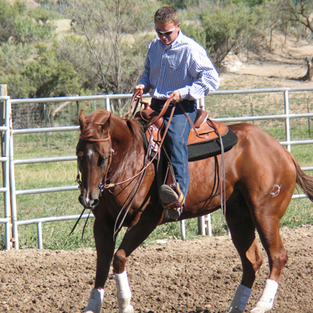Steering the Tail Exercise, Part 2: What To Do If
July 10, 2014
Written by: Josh Lyons & Keith Hosman
Written by: Josh Lyons & Keith Hosman
|
Note: This is a follow-up article to the "Steer the Tail" exercise. (Think of this one as "Part 2 of 2.") Click here to jump back to part 1.
The "Steer the Tail Exercise": What You Should Expect The "Steer the Tail" training exercise will have the effect of awakening your horse to the touch of the rein. Following patient practice, you'll find your horse calmer, softer and more willing to keep a bend in his body. Plus, you'll have a way to teach him to turn - not drift - through his circles. For all horses, young and old. Whether you're training a young or old horse, you need to steer him, right? Here's the follow-up article to our Steer The Tail exercise, explaining exactly What To Do If.... 
What If?... If you get a slingshot action with the horse's head, where you pull it back and they give but immediately throw it forward, then move your hands a little slower. Hold on longer, move slower to give back. Make them hold a little longer, until they really soften up, then slowly give it back and change direction.
Why Am I Doing This Again? Your horse "powers himself" from the hindquarters. Being able to "disengage" the hips allows you to unplug that power or use it to your advantage. You can move the hips to discourage your young horse from bucking or rearing. This training exercise also gives you a terrific way to begin teaching direct reining or reinforce your direct rein if your horse misses a turn: Pick up the rein and say "No, we're going THAT way.” Keeping The Following In Mind Will Help You: A horse always has one good side and one bad side. The problem is that it keeps changing. The left side might be good now and the right side is the bad side. You'll work on that for fifteen minutes - and all of a sudden the right side is the good side and the left side is the bad side. It'll keep going back and forth. Smile, it's just part of training.
Common Mistake: Doing a U-Turn instead of insisting that the tail pivot around the shoulders like the hands of a clock. Watch that inside shoulder until it stops - that's when you're moving the hips correctly. Remember to time your release in order to let the horse know that that's what you've been looking for. Don't: Ride in a straight line. You shouldn't take more than two steps in a straight line before turning. Getting a young horse to travel straight is a perfection of going left and right. If I can't get my horse to travel straight, it's because he's either going left or right. If he's going left when I'm asking him to go straight, that means he's not responding to my right cue. (That is "turn right.”) So in your training you should work on going left and right. The more you work on left and right, the easier "straight” is. Do: Sit up. If your nose gets beyond that [EPN Link 1: saddle] horn your body will get out of position. If he stops hard or does something, your body will have a tendency to fall forward. If you're kicking and that horse isn't moving, you keep bumping and pick up that rein. If you bump and he's not moving, keep bumping, don't bump harder, pick up that rein and make him move. That rein is more powerful that your legs are. Put more pressure on that rein and have that hip move over. If a horse locks up and you keep driving him with your legs what is going to happen eventually, if he does go, you're going to get too much energy. He's going to lurch forward or bolt or jump on you. What will happen is that you will put too much energy into your horse too fast and you can lose control of him. Note: This is a follow-up article to the "Steer the Tail" exercise. (Think of this one as "Part 2 of 2.") Click here to jump back to part 1. Get your horse to stop now, not later. If it takes 2 seconds to go from a walk to a stop - multiply that by 8 when he's excited. Click here to read the "Hip-Shoulder-Shoulder" 3-part series of article - and get that stop the easy way!
Wanna teach your horse to drop its head and stay relaxed? When you're finished with this article, click here to read about the "Classic Serpentine."
|
|

